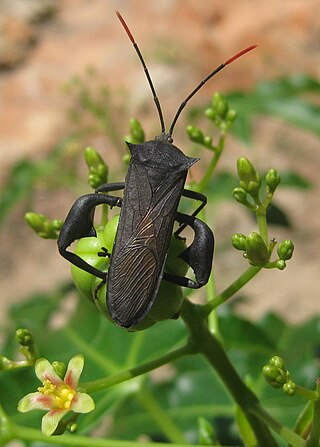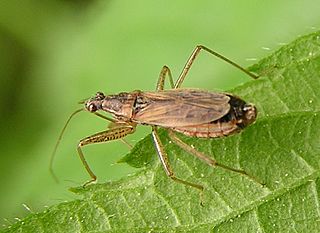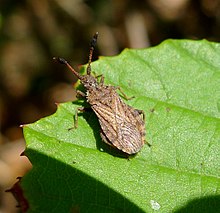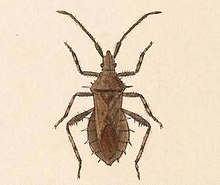
Pentatomidae is a family of insects belonging to the order Hemiptera, generally called shield bugs or stink bugs. Pentatomidae is the largest family in the superfamily Pentatomoidea, and contains around 900 genera and over 4700 species. As hemipterans, the pentatomids have piercing sucking mouthparts, and most are phytophagous, including several species which are severe pests on agricultural crops. However, some species, particularly in the subfamily Asopinae, are predatory and may be considered beneficial.

Coreidae is a large family of predominantly sap-sucking insects in the Hemipteran suborder Heteroptera. The name "Coreidae" derives from the genus Coreus, which derives from the Ancient Greek κόρις (kóris) meaning bedbug.

The insect family Nabidae contains the damsel bugs. There are over 500 species in 20 genera. They are soft-bodied, elongate, winged terrestrial predators. Many damsel bugs catch and hold prey with their forelegs, similar to mantids. They are considered helpful species in agriculture because of their predation on many types of crop pests.

Anthocoridae is a family of bugs, commonly called minute pirate bugs or flower bugs. Worldwide there are 500-600 species.

Alydidae, commonly known as broad-headed bugs, is a family of true bugs very similar to the closely related Coreidae. There are at least 60 genera and 300 species altogether. Distributed in the temperate and warmer regions of the Earth, most are tropical and subtropical animals; for example Europe has a mere 10 species, and only 2 of these occur outside the Mediterranean region.

Anisoscelini is a tribe of leaf-footed bugs in the family Coreidae. It was formerly spelled Anisoscelidini, but the tribal name spelling was incorrectly formed.

Heterogastridae is a family of lygaeoid bugs consisting of about 20 genera and more than 100 species.

Schizopteridae is the largest family in the infraorder Dipsocoromorpha and comprises 56 genera and approximately 255 species. Schizopterids are some of the smallest (0.5–2.0 mm) true bugs. Members of this family can be distinguished by their small size, enlarged forecoxae and varying degree of abdominal and genitalic asymmetry in males. Schizopteridae exhibit a wide range of simple and complex wing venation patterns. The group is currently divided into three subfamilies: Schizopterinae, Ogeriinae and Hypselosomatinae.

Bryocorinae is a subfamily of bugs in the family Miridae.

Rhopalinae is a subfamily of scentless plant bugs in the family Rhopalidae. There are more than 170 described species in Rhopalinae.

Cardiastethus is a genus of minute pirate bugs in the family Lyctocoridae. There are more than 20 described species in Cardiastethus.

Cydninae is a subfamily of burrowing bugs in the family Cydnidae. There are about 11 genera and at least 40 described species in Cydninae.

Oxycarenidae is a family of true bugs in the order Hemiptera. There are more than 20 genera and 140 described species in Oxycarenidae.

Acanthocephalini is a tribe of leaf-footed bugs in the family Coreidae. There are at least 100 described species in Acanthocephalini found in the Americas.

Geocoridae is a family of big-eyed bugs in the order Hemiptera. There are more than 290 described species in Geocoridae.
Meropachyinae is a subfamily of leaf-footed bugs in the family Coreidae. There are at least 50 described species in Meropachyinae, recorded from the Americas.

Gampsocorinae is a subfamily of stilt bugs in the family Berytidae. There are about 60 described species in Gampsocorinae.
Pagasa is a genus of damsel bugs in the family Nabidae. There are about 11 described species in Pagasa.

















